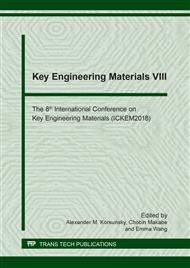[1]
E. P. Giannelis, R. Krishnamoorti, E. Manias, Polymer-silicate nanocomposites: model systems for confined polymers and polymer brushes, Adv. Polym. Sci. 138 (1999) 107-147.
DOI: 10.1007/3-540-69711-x_3
Google Scholar
[2]
M. Biswas, S. Ray, Recent progress in synthesis and evaluation of polymer-monmorillonite nanocomposites, Adv. Polym. Sci. 155 (2001) 167.
Google Scholar
[3]
P. C. LeBaron, Z. Wang, T. J. Pinnavaia, Polymer-layered silicate nanocomposites: an overview, Appl. Clay Sci. 15 (1999) 11-29.
DOI: 10.1016/s0169-1317(99)00017-4
Google Scholar
[4]
E.M. Genies, A. Boyle, M. Lapkowski, C. Tsintavis, Polyaniline: a historical survey, Synth Met. 36 (1990) 139–182.
DOI: 10.1016/0379-6779(90)90050-u
Google Scholar
[5]
K.M. Molapo et al., Electronics of conjugated polymers (I): polyaniline, Int. Journ. of Electrochem. Sci. 7 (2012) 11859-11875.
Google Scholar
[6]
A.K. Bakhshi, G. Bhalla, Electrically conducting polymers: materials of the twenty first century, Journal of Scientific & Industrial Research, 63 (2004) 715-728.
Google Scholar
[7]
V. Kularni, L. Campbell, W. Mathew, Thermal stability of polyaniline, Synth. Met. 30 (1989) 321 – 325.
Google Scholar
[8]
J. Stejskal, Colloidal dispersions of conducting polymers, Polymer Materials. 18 (2001) 225–258.
Google Scholar
[9]
S. Bhadra, N.K. Singha, D. Khastgir, Semi-conductive composites from ethylene 1-octene copolymer and polyaniline coated nylon 9: studies on mechanical, thermal, processability, electrical, and EMI shielding properties, Polymer Eng Sci. 48 (2008).
DOI: 10.1002/pen.21025
Google Scholar
[10]
I.E. Odom, Na/Ca montmorillonite: properties and uses, Society of Mining Engineers Transactions, 282 (1986).
Google Scholar
[11]
A.C.D. Newman, Chemistry of Clays and Clay Minerals, John Wiley and Sons, New York, (1987).
Google Scholar
[12]
S. Lim, C. Gomes, M.Z.D. Ab Kadir, Characterizing of bentonite with chemical, physical, and electrical perspectives for improvement of electrical grounding systems, Int. J. Electrochem. Sci. 8 (2013) 11429 – 11447.
Google Scholar
[13]
A. K. G. Tapia, K. Tominaga, Conduction in polyaniline emeraldine salt in the terahertz region: A temperature dependence study, Chemical Physics Letters, 598 (2014) 39-42.
DOI: 10.1016/j.cplett.2014.02.055
Google Scholar
[14]
S. Madakbas, K. Esmer, E. Kayahan, M. Yumak, Synthesis and dielectric properties of poly(aniline)/Na bentonite nanocomposite, Sci and Eng of Composite Mat. 17 (2010) 145-153.
DOI: 10.1515/nano.0044.00004
Google Scholar
[15]
B. Vijayakumar, K.O. Anjana, G. Ranga Rao, Polyaniline/clay nanocomposites: preparation, characterization, and electrochemical properties, IOP Conf. Series: Materials Science and Engineering 73 (2015) 012112.
DOI: 10.1088/1757-899x/73/1/012112
Google Scholar
[16]
M. Vellakkat, A. Kamath, S. Raghu, S. Chapi, D. Hundekal, Dielectric constant and transport mechanism of percolated polyaniline nanoclay composites, Ind. Eng. Chem. Res. 53 (2014) 16873−16882.
DOI: 10.1021/ie502922b
Google Scholar
[17]
M. Ohaycabal, T. Olinga, M-P. Foulc, V. Vigneras, Polyaniline/clay as nanostructured conductive filler for electrically conductive epoxy composites. Influence of filler morphology, chemical nature of reagents, and curing conditions on composite conductivity, Syn. Met. 162 (2012).
DOI: 10.1016/j.synthmet.2012.02.011
Google Scholar
[18]
J.D. Sudha, S. Sivakala, R. Prasanth, V.L. Reena, P. Radhakrishnan Nair, Development of electromagnetic shielding materials from the conductive blends of polyaniline and polyaniline-clay nanocomposite-EVA: Preparation and properties, Comp. Sci. and Tech. 69 (2009).
DOI: 10.1016/j.compscitech.2008.10.026
Google Scholar
[19]
J. Lloyd-Hughes, T. I. Jeon, A review of the terahertz conductivity of bulk and nano-materials, Journal of Infrared, Millimeter, and THz Waves. 33 (2012), 871-925.
DOI: 10.1007/s10762-012-9905-y
Google Scholar
[20]
N. F. Mott, E. A. Davies, Electronic processes in non-crystalline materials, Clarendon Press, Oxford, (1979).
Google Scholar
[21]
K. Funke, Jump relaxation in solid electrolytes, Progress in Solid State Chemistry, 22 (1993) 111-195.
DOI: 10.1016/0079-6786(93)90002-9
Google Scholar
[22]
L. Zhirong, Md. Azhar Uddin, S. Zhanxue, FT-IR and XRD analysis of natural Na-bentonite and Cu(II)-loaded Na-bentonite, Spectrochimica Acta Part A: Molecular and Biomolecular Spectroscopy, 79 (2011) 1013-1016.
DOI: 10.1016/j.saa.2011.04.013
Google Scholar
[23]
N.V. Smith, Physical Review B, 64 (2001) 155-106.
Google Scholar


